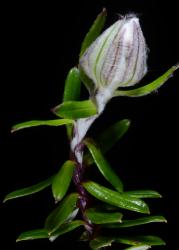- Taxon
- Gallery
- ≡ Gnaphalium subrigidum Colenso, Trans. & Proc. New Zealand Inst. 17: 245 (1884 [1885]) – as Gnaphalium sub-rigidum
- ≡ Anaphalis subrigida (Colenso) C.J.Webb, New Zealand J. Bot. 25: 147 (1987)
- = Gnaphalium keriense var. linifolia Hook.f., Bot. Antarct. Voy. II. (Fl. Nov.-Zel.) Part I, 138 (1853)
Plant erect, candelabriform. Stems 1.5-3.5 mm diameter. Branches sparse, 10-25 cm long, roots from the branches absent, dark purple distally, internodes 1-3 mm. Leaves at 45° to the stem, 14—24 mm long, 1.7-5.0 mm wide, narrowly oblong; apiculus 0.4 mm long, dark red; upper surface glabrous; veins entering leaf 3; margins revolute. Flowering stem 22-27 cm long, 0.8-1.0 mm diameter, dark purple, densely hairy, transition to scape leaves abrupt; scape leaves very narrowly ovate, 9-10 mm long, 0.6-1.0 mm wide. Inflorescence compound, capitula per inflorescence 6-9. Capitula 9-13 mm diameter in dried specimens. Receptacle 2.2-3.0 mm diameter, conical, 0.5- 1.3 mm high. Outer involucral bracts 4.7-5.7 mm long, 0.6-1.9 mm wide; gap clear. Inner involucral bracts 3.8-6.1 mm long, 0.5-1.3 mm wide. Hermaphrodite florets 2.52 mm long; corolla 2.2- 2.7 mm long, 0.6 mm wide, lobes 0.45 mm long; anthers 1.03-1.1 mm long, 0.17 mm wide, apices 0.15 mm long, anther tails, 0.2 mm long; style 2 mm long; pappus hairs 10-15 per floret, 1.75-2.35 mm long, apical cells clavate. Female florets 2.56- 2.76 mm long; corolla 1.9-2.4 mm long; style 1.87- 2.2 mm long; style arms 0.25 mm long; pappus hairs 5-11 per floret, 1.4-2.0 mm long, apical cells clavate. Achenes 0.60 mm long, 0.20-0.24 mm diameter, hairs absent. Florets 170-251, female florets 81-90% of total number.
[Reproduced from Glenny (1997, New Zealand J. Bot. 35: 451-477) with permission from The Royal Society of New Zealand.]




